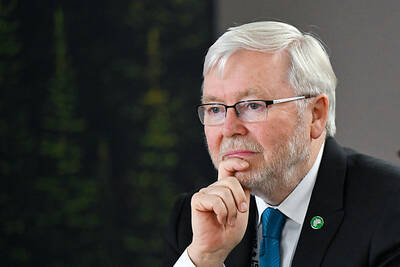Wall Street ended a painful year with another steep loss on Monday as investors glumly anticipated that this year would bring more of the uncertainty and turbulence of last year.
The Dow Jones industrials fell 101 points, the latest in a string of triple-digit moves that became commonplace in the just-ended year amid a continuum of bad news about housing, faltering mortgages and shrinking credit. Thanks to a big first-half advance, they managed to finish last year with a respectable increase of 6.43 percent -- not as large as the 16.29 percent jump in 2006, but a better performance than the modest loss in 2005.
The Dow's annual gain came even after it posted its worst fourth-quarter drop in 20 years, amid billion-dollar losses at the world's biggest financial firms and falling spending by consumers whose budgets have been crimped by record-high oil prices and declining home prices.
"Considering all that's going on, the market really acted pretty well," said Todd Leone, managing director of equity trading at Cowen & Co.
It's tough to say what the primary market driver of the new year will be, but the stock market faces a slew of threats: more adjustable-rate mortgage resets, a still-tight credit market and the possibility of accelerating inflation. But Leone said the fourth-quarter earnings season in January should shed some light on how US companies are surviving the recent slowdown and credit crunch.
There was more downbeat news on housing on Monday. The National Association of Realtors said November existing home sales rose 0.4 percent to an annual rate of 5 million -- the first rise in nine months. However, sales are 20 percent below where they were a year ago, and the median existing home price has dropped 3.3 percent over the past 12 months.
Falling home prices have made it hard for struggling homeowners to refinance their mortgages, and the slump in construction activity has hurt homebuilders and other housing-related industries.
Still, there were some slivers of optimism on Monday. The UK's Observer newspaper reported on Sunday that Merrill Lynch & Co was in talks over the weekend to line up capital from investors in China and the Middle East in exchange for portions of the Wall Street firm.
Merrill, like many other financial houses, has seen its portfolio lose billions of dollars in value due to misplaced bets on mortgages. And as Citigroup Inc, UBS AG, Morgan Stanley and Bear Stearns Cos have done, it has turned to investors in Asia for much-needed capital -- Merrill has already gotten US$4.4 billion this month from a Singapore fund, which bought a 9.9 percent stake in the US brokerage.
The Dow fell 101.05, or 0.76 percent, to 13,264.82. The blue-chip index remains below its Oct. 9 record high of 14,164.53, at which point it was up more than 13 percent year-to-date.
The Standard & Poor's 500 index and the technology-dominated NASDAQ composite index also declined on Monday, but both posted annual gains for the fifth straight year.
The S&P 500 index fell 10.13, or 0.69 percent, to 1,468.36, to end the year with a gain of 3.53 percent. It had reached a record close of 1,565.15 on Oct. 9.
The NASDAQ fell 22.18, or 0.83 percent, to 2,652.28, to finish the year with a 9.81 percent gain. Despite the market's volatility, this was the best performance for the NASDAQ -- still well below its tech boom highs -- since 2003.
Government bonds rose. The yield on the benchmark 10-year Treasury note, which moves opposite its price, slid to 4.03 percent from 4.12 percent late on Friday, and is down nearly 17 percent for the year.
Declining issues narrowly outnumbered advancers on the New York Stock Exchange. Consolidated volume came to a light 2.38 billion shares, up slightly from 2.31 billion on Friday.
Last year was a remarkable year on Wall Street. The market began the year continuing the rally that propelled the Dow above 12,000 for the first time in October 2006. Then, in late February, came a reminder that stocks were capable of turning tail and plunging -- a skid on China's stock market and an ominous economic outlook from former Federal Reserve Chairman Alan Greenspan sent the Dow down 416 points in one day.
That panic didn't last long. In April, the Dow barreled above 13,000 for the first time and then glided past 14,000 in mid-July. But in late July, however, the market realized that the ongoing slump in housing and a rise in mortgage foreclosures because of resetting on adjustable-rate loans, was taking a toll across the credit markets.
Though the housing market started teetering as early as 2005, few people anticipated how much the downturn could affect the global financial system. Mortgages given to borrowers deemed "subprime" comprised only about an eighth of the US$10 trillion US mortgage market -- why would that rattle the world markets?
The problem was, these pieces of debt were chopped up, repackaged and woven into larger fixed-income instruments, on which banks and other investors made billion-dollar bets -- bets that were extremely profitable during the housing boom, but calamitous when borrowers couldn't keep up with their mortgage payments. When one slice of the instrument defaulted, it pulled the whole thing down with it.
Investors bailed out of anything tied to mortgages, and soon Wall Street discovered that financial institutions in the US and overseas were holding billions of dollars in assets that were losing value by the day. The biggest names on the Street -- Merrill Lynch, Citigroup Inc, Bear Stearns Cos -- announced billions of dollars in writedowns. Merrill and Citi lost their CEOs, and several financial firms sought out billion-dollar investments to clean up their balance sheets.
In the midst of this turmoil, the credit markets all but seized up, and all these interconnected events pummeled stocks. The Dow suffered triple-digit drops, the Russell 2000 index of smaller companies fell 5.73, or 0.74 percent, to 766.03 on Monday. The small-cap index finished the year down 2.75 percent.

NEXT GENERATION: The four plants in the Central Taiwan Science Park, designated Fab 25, would consist of four 1.4-nanometer wafer manufacturing plants, TSMC said Taiwan Semiconductor Manufacturing Co (TSMC, 台積電) plans to begin construction of four new plants later this year, with the aim to officially launch production of 2-nanometer semiconductor wafers by late 2028, Central Taiwan Science Park Bureau director-general Hsu Maw-shin (許茂新) said. Hsu made the announcement at an event on Friday evening celebrating the Central Taiwan Science Park’s 22nd anniversary. The second phase of the park’s expansion would commence with the initial construction of water detention ponds and other structures aimed at soil and water conservation, Hsu said. TSMC has officially leased the land, with the Central Taiwan Science Park having handed over the

AUKUS: The Australian Ambassador to the US said his country is working with the Pentagon and he is confident that submarine issues will be resolved Australian Ambassador to the US Kevin Rudd on Friday said that if Taiwan were to fall to China’s occupation, it would unleash China’s military capacities and capabilities more broadly. He also said his country is working with the Pentagon on the US Department of Defense’s review of the AUKUS submarine project and is confident that all issues raised will be resolved. Rudd, who served as Australian prime minister from 2007 to 2010 and for three months in 2013, made the remarks at the Aspen Security Forum in Colorado and stressed the longstanding US-Australia alliance and his close relationship with the US Undersecretary

‘WORLD WAR III’: Republican Representative Marjorie Taylor Greene said the aid would inflame tensions, but her amendment was rejected 421 votes against six The US House of Representatives on Friday passed the Department of Defense Appropriations Act for fiscal 2026, which includes US$500 million for Taiwan. The bill, which totals US$831.5 billion in discretionary spending, passed in a 221-209 vote. According to the bill, the funds for Taiwan would be administered by the US Defense Security Cooperation Agency and would remain available through Sept. 30, 2027, for the Taiwan Security Cooperation Initiative. The legislation authorizes the US Secretary of Defense, with the agreement of the US Secretary of State, to use the funds to assist Taiwan in procuring defense articles and services, and military training. Republican Representative

TAIWAN IS TAIWAN: US Representative Tom Tiffany said the amendment was not controversial, as ‘Taiwan is not — nor has it ever been — part of Communist China’ The US House of Representatives on Friday passed an amendment banning the US Department of Defense from creating, buying or displaying any map that shows Taiwan as part of the People’s Republic of China (PRC). The “Honest Maps” amendment was approved in a voice vote on Friday as part of the Department of Defense Appropriations Act for the 2026 fiscal year. The amendment prohibits using any funds from the act to create, buy or display maps that show Taiwan, Kinmen, Matsu, Penghu, Wuciou (烏坵), Green Island (綠島) or Orchid Island (Lanyu, 蘭嶼) as part of the PRC. The act includes US$831.5 billion in